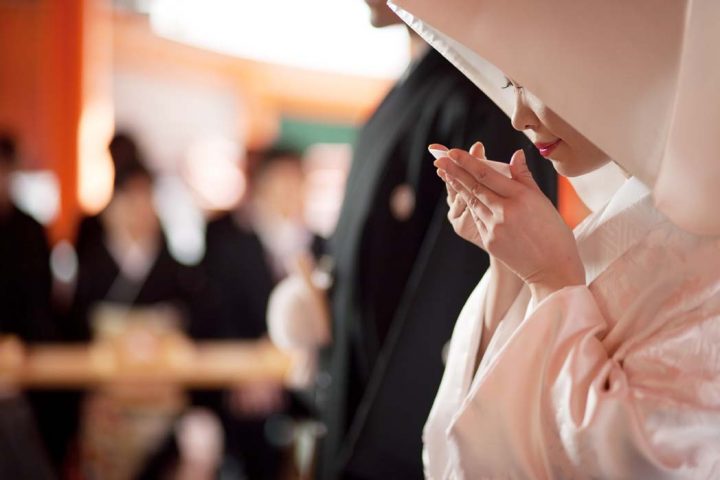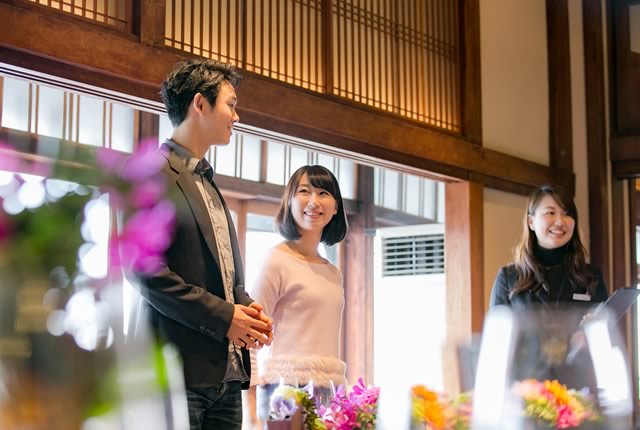2024.06.13

Shinto wedding ceremonies are based on the ancient Japanese Shinto tradition.
Shinto is an ancient Japanese religion in which all natural objects are believed to be inhabited by deities.
This is a traditional Japanese style and can be performed even if the couple performing the ceremony is not believers in Shinto.
It is said that the first Shinto wedding ceremony was held at the Tokyo Daijingu for Emperor Taisho and his wife in the latter half of the Meiji period (1868-1912), and since then, the Shinto wedding ceremony has become a subject of public admiration.
For this reason, the Tokyo Daijingu is said to be the first venue for Shinto wedding ceremonies.
In Japan, it is mainly held at shrines, giving a sense of very Japanese and tradition.
Although there are some differences from wedding hall to wedding hall, the process often goes as follows.
① Shyubastu(Purification Rite)
After the attendees enter and are seated, they all stand up to receive a purification ceremony called Shubatsu.
Shubatsu is a ceremony to purify the bride and groom, as well as the attendants, in order to welcome the gods.
② Norito-sojyou(Reading of sacred words)
It is a kind of initial greeting by the priest who reports the couple’s marriage to God.
When finished, the attendees are seated.
③ Sankon-no-gi(Exchanging of nuptial cups)
The sanken-no-gi is a ceremony in which the bride and groom take turns drinking from small, medium, and large cups of omiki (sacred wine) poured by the miko (shrine maidens).
Drink 3 cups each, for a total of 9 drinks.
1 cup … Groom to Bride
2 cups… Bride to Groom
3 cups… Groom to Bride
Non-drinkers need only sip from the cup and do not need to finish it.
There is only one sake cup used in this ceremony, and the groom and bride take turns drinking from the same one.
This is meant to indicate that we will share the hardships and joys of the future.
⑤ The Ring Ceremony
The bride and groom pledge their eternal love and exchange rings.
The wedding rings are placed on the ring finger of the left hand by the groom to the bride and by the bride to the groom on each other.
⑥ Reading of the Vows
It is an oath to God that two people have entered into the bonds of matrimony.
The vows vary slightly from shrine to shrine, but the bride’s and groom’s names are written on the words prepared in advance and can be recited.
Of course, you can also prepare your own ideas.
⑦ Tamagushi-houten(Tamagushi rite)
The bride and groom will then perform the Tamagushi offering ceremony, followed by a ceremony of Tamagushi offering by the bartender (a role similar to that of a matchmaker who witnesses the ceremony only during the ceremony).
Tamagushi Houten is a ceremony performed using a sakaki branch. The sakaki is an evergreen plant that is believed to be the dwelling place of the gods, and to this Sakaki is tied a paper or hemp cord called a Shide.
After receiving the Tamagushi from the priest or priestess and offering it with the base toward the altar, the participants bow in the manner of two claps of the hands and one bow of the hands.
⑧ Shinzoku Katame-no-sakazuki(Bond-tying rite)
Sake is distributed to the attending relatives, and everyone drinks it all at once.
⑨ Saishyu-ippai(Last Greeting)
The ceremony ends with the priest’s closing remarks.
Stand up in accordance with the host and greet God once again. By bowing to the God who has blessed your marriage, you can express your deep gratitude.
1 Good Old Japanese Traditions
In a solemn, uniquely Japanese building, you will be able to take your vows to become husband and wife in an atmosphere of serenity and tranquility.
Options that can be staged include dances by miko (shrine maidens) and live gagaku (ancient Japanese court music).
Bonfires are lit for evening and night ceremonies, oozing traditional Japanese flair.
2 Wear a Kimono
The basic costume for a Shinto ceremony is a kimono such as Shiro-Muku (white kimono) or Shiro-Uchikake (colored kimono).
The space of the historic shrine combined with the kimono makes the bride and groom look even more beautiful.
A solemn, secluded, old-fashioned Japanese wedding will make the bride look even more beautiful.
3 Strengthening Family Bonds
There is a ceremony in which the bride, groom, and family members walk in a line through the shrine grounds to the temple.
The charm of the Shinto wedding ceremony is that there are many occasions where the bond between the two families is strengthened in a sacred place.
Kyoto, the ancient capital representing Japan. Why don’t you hold your wedding ceremony in Kyoto where you can feel the good old Japanese culture?
Another attraction of a Shinto Wedding Ceremony is that even after the ceremony, you can return again and again to the shrine as a place of remembrance.
Why not hold your wedding ceremony in a sacred place in Kyoto, such as Heian Shrine, a World Heritage site, that is uniquely yours?
We offer a number of packages that include a shrine and wedding reception on our website.
Click here for details.
(kyoto-kon.com)
Wearing a white kimono and cotton hat, a Shinto Wedding Ceremony is hold at a shrine in Kyoto.
It gives a sense of Kyoto-like atmosphere, and more and more couples are opting for a Shinto Wedding Ceremony.
Shinto wedding ceremonies are also recommended for those who are considering an elopement wedding, as the ceremony will be held for a small number of people.
Choose a Shinto Wedding Ceremony that incorporates Japanese traditions, and have the entire city of Kyoto, with its quaint Japanese atmosphere, bless you.

■京都婚体験相談会にも注目
神社、披露宴会場の知りたい情報がまとめてわかる
体験型イベントを毎週開催。
詳しくはこちらから
京都での結婚式についてもっと知りたい方、お気軽にご相談ください。
TEL:0120-075-881
(受付時間 平日:12:00〜19:00/土日祝:10:00〜19:00)